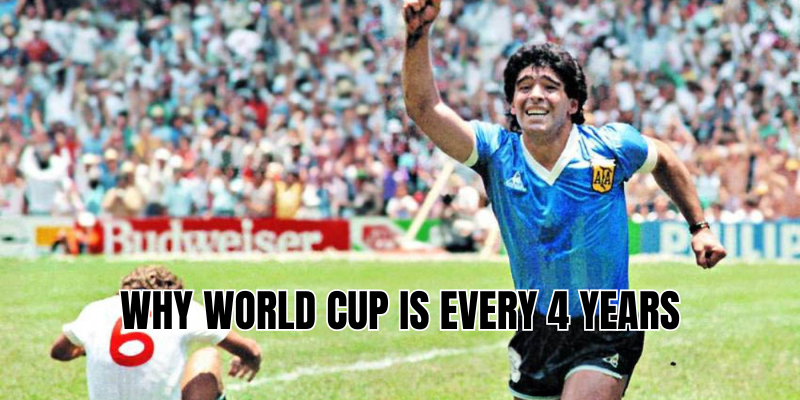Have you ever asked, why World Cup is every 4 years? It’s more than tradition. Between the qualification marathon, the logistics, players’ workloads, and preserving the prestige of football’s biggest show, there are solid reasons behind the four-year cycle. In this article, ZizaGoal will explore those reasons richly.
History of the four-year cycle

The tournament has usually followed a four-year rhythm, with two big interruptions during World War II (1942, 1946) when it was canceled. The decision for a quadrennial (every four years) cycle came down to the needs of the qualifiers, travel constraints, and giving host nations time to prepare. When the World Cup started, travel was slow, infrastructure limited, and fewer national associations had strong resources. All that meant tasks that seem easier now—stadium building, organizing international qualifiers, planning fan arrival—were massive logistical feats. Over time this schedule became tradition, and tradition carries weight in football. Today, that rhythm helps set expectations: fans mark four years between chances to see their country lift the trophy.
Key reasons for holding the World Cup every four years

Here are the major factors that explain why World Cup is every 4 years, both from the past and in modern times:
Qualification process demands
- There are over 200 national associations that compete for a limited number of spots. Running qualifiers across Asia, Africa, Europe, South America, Oceania, and North America takes time. Multiple match windows, home and away legs, playoffs — it’s a long road.
- Spreading qualifiers over several years helps avoid overload in single seasons, and gives smaller nations time and chance to prepare.
Logistical and organizational complexity
- Hosting a World Cup is a massive endeavor: stadiums, transportation, hotels, training facilities, fan zones, security, media infrastructure—even telecommunication and broadcasting networksed big investment. Hosts need years to build or upgrade.
- Travel and scheduling across time zones matter. Before modern air travel, moving teams, especially. The four-year cycle gave more cushion for those constraints.
Player welfare, calendar constraints
- Players already have heavy workloads: domestic leagues, continental club competitions (Champions League, AFC Champions League, etc.), national team qualifiers, other tournaments. Adding a major tournament every 2 years would burden them, risk injuries, and lead to fatigue.
- The football calendar is already crowded — international breaks are limited. To maintain quality, fairness, and freshness, spacing out major tournaments helps.
Maintaining prestige and rarity
- The gap makes winning the World Cup feel more special. Each squad’s opportunity is rare; stars age, form changes, people retire. It builds anticipation, lore, memory.
- If the tournament were every 2 years, there’s concern it could dilute its uniqueness, commercial value, and fan engagement.
Host country preparation and infrastructure
- Hosts need time to plan: stadiums, roads, airports, accommodations, security, financial investments. Big stadiums, fan villages, media contingents—it’s not something that can be done last minute.
- Also, bidding and selection processes, which often start years in advance, require planning cycles that align with a four-year schedule. Changing that cycle would complicate bidding, preparations, and continuity.
Modern pressures and the debate over changing frequency

Recently, there’s been discussion about whether the World Cup should be held every two years instead of four. ZizaGoal takes you through what that debate involves — the arguments, who supports it, who resists, and what obstacles exist.
What’s being proposed
- Some within FIFA have supported a proposal for a biennial World Cup cycle, both for the men’s and women’s tournaments. The idea is to expand revenue opportunities, give more chances for nations to participate in finals, and make the global calendar more dynamic.
- Advocates argue this could raise visibility of international football, help smaller football nations get more exposure, and better balance thewer and attention between club and international competitions.
Objections and downsides
- Player burnout: more tournaments mean less rest. Domestic and club competitions are not going awaydding extra World Cups compresses everything.
- Calendar congestion: national teams, clubs, continental competitions, regional cups, even youth tournaments all have to fit. More major tournaments could clash.
- Financial, logistical, and brand concerns: Is there enough host readiness every two years? Would sponsors, broadcasters, ticket buyers tolerate shorter buildup, or would the quality suffer? Could prestige be diluted?
Current status
- As of now, no final decision has been made to shift to a two-year cycle. FIFA did mandate studies into feasibility, consulting confederations like UEFA about calendar, impact, brand value, etc.
- Many in Europe, including major leagues and UEFA, have expressed serious reservations. They argue that stability in planning—fixtures, broadcasting, club vs. country balance—is critical, and any change risks upsetting many stakeholders.
Comparison: other tournaments and cycles
To understand the four-year cycle better, it helps to look at how other major tournaments do scheduling, and what lessons we can draw.
- Olympic Games happen every four years. FIFA’s World Cup scheduling has parallels here: large scale, multi-national, huge logistical demands. The Olympic tradition helped influence many sports, including football, in thinking about quadrennial major events.
- UEFA European Championship (Euros) also run every four years, offset between World Cups. This allows a major international tournament almost every two years (World Cup, then Euros, then back), keeping fan interest high.
- Club competitions: these are annual or seasonal (yearly), which shows that football frequently has big tournaments—just at different levels. International major tournaments are meant to be special, less frequent.
Forecast: Will the cycle change?
So, given all pressures, will we ever see a World Cup every two years?
- It’s possible but unlikely soon. Many stakeholders want more data on impact: how would biennial tournaments affect player health, club incomes, viewer fatigue, host readiness?
- Any change would require coordinated agreement among FIFA, continental confederations, leagues, clubs, players, and broadcasters. Because almost everyone has something to lose or gain, consensus is hard.
- The 2026 World Cup will already be under a new expanded format—48 teams instead of 32—which itself raises questions about match load, group stages, hosting. Adjustments like that will test whether the current four-year rhythm still works well.
Conclusion
Why world cup is every 4 years isn’t just tradition — it’s a balance of logistics, prestige, player welfare, and global football infrastructure. ZizaGoal has shown you how the qualification process, host nation planning, and maintaining the special status of the tournament all point to a four-year cycle as the most sustainable and meaningful.
If you’re a fan, here’s what to do next: pay attention to upcoming FIFA congresses, listen to players’ voices about schedule stress, watch how the 2026 expansion works out (bigger tournament, more teams), and judge whether push toward a biennial World Cup makes sense.
Want more? ZizaGoal invites you to explore how this cycle compares with women’s World Cup scheduling, or what fans think about a biennial model — drop a comment or send us suggestions for our next deep-dive!







